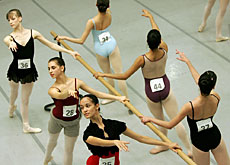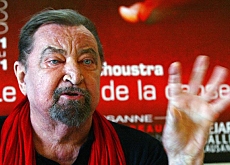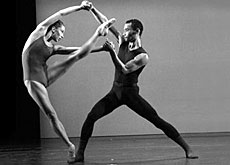Looking for the ballet stars of tomorrow

The Prix de Lausanne, Switzerland's prestigious ballet competition for aspiring young dancers, is celebrating its 35th anniversary this year.
The international contest is a springboard to the next step in a dancer’s career, aiming to reward potential over achievement. It counts many famous dancers among its former winners.
Lausanne’s Beaulieu theatre in western Switzerland has been transformed into a hive of activity. Some rooms have been converted into studios, complete with barres and mirrors. The stage has been prepared for the competition.
Young dancers, all of them between 15 and 18 years old, are scattered around, chatting, practising their steps and stretching.
It is the day before the competition begins and the 43 girls and 19 boys from all over the world have gathered for warm-up classes in ballet and contemporary dance, as well as to practise some of their dance pieces on stage.
“It’s the rehearsals, so we’ve already started to look at the other candidates and to compare ourselves a little bit,” explained 16-year-old Laure Bogtchalian from Marseille, France.
The competition’s quarterfinals will start on Wednesday, but the jury will be following the candidates all week, as they will also attend some classes. The final, for which up to 12 young dancers will be selected, will take place on Sunday.
Pressure
For Laure, the competition environment is a good one. “You experience some stress and pressure, which is motivating. Of course it can become a little discouraging when you see all these great dancers. But I think it’s a positive kind of stress.”
Most students agree that the Prix can be an important career step – the prizes are a year in a renowned ballet school or an apprenticeship to an established ballet company.
“The doors open with opportunities,” said 15-year-old Australian Shannon Robinson. “It’s just a really good experience.”
Shannon is one of eight Australian girls who have made the long journey to Lausanne. “A lot of us haven’t had the chance to dance overseas and [it’s good] to see what everyone else is like,” she told swissinfo.
The Australians are the second largest contingent – behind the Japanese with nine candidates.
Asian boom
“The Prix is very famous in Japan because it’s a big competition and everyone knows it,” said 17-year-old Japanese dancer Yoshihisa Arai.
Over the past few years the competition has seen a big boom in Asian candidates – Koreans and Chinese are also taking part – and they often do well. Last year they won four of the six prizes.
“Japanese, Korean and Chinese dancers have this willpower that sometimes tends to lack a little bit now in western counties which makes them very good candidates,” Patricia Leroy, the secretary general of the Prix, told swissinfo.
In all 27 nations are represented at the Prix but there are no Swiss this year, mainly because the country’s small size means it produces few dancers.
Potential
Over the course of the week the jury will be looking for potential rather than technical achievement. This differs from other competitions, says Leroy.
The policy seems to work – over the past 35 years the Prix has had an impressive track record, counting the London Royal Ballet’s Alina Cojocaru and Carlos Acosta among its past winners.
But Leroy says all participants gain something from the competition, benefiting from coaching and jury feedback.
She says the Prix – and its dancers – have come a long way since it 1973 when it was a “short and strict” competition.
“Each year I think this is the most wonderful one we’ve had, and the next year it’s even better. It’s just amazing how these kids develop and train and give their best. It’s just a wonder every time.”
swisssinfo, Isobel Leybold-Johnson in Lausanne
The prizes take the form of a scholarship, which allows the winner to gain access to a renowned ballet school, or an apprenticeship, which allows entry without audition to a top ballet company. They both last a year.
There is also a prize for contemporary dance, consisting of a contemporary dance summer course.
All finalists who did not get a prize receive SFr1,000 ($800). Also awarded is an audience favourite prize.
The Prix de Lausanne was set up in 1973 by Philippe and Elvire Braunschweig as a competition for young dancers.
In 1998 it changed direction, giving more weight to contemporary dance and the pedagogical aspect of the competition.
Candidates now have to present three dances – two classical and one contemporary by Czech choreographer Jiří Kylian.
Health is also important, with the competition stressing the benefits of healthy eating and dancers looking after their bodies.
A special performance by past winners will be held to mark the 35th anniversary. A seminar on ballet and business will also be held and an urban installation has been built in the town centre.

In compliance with the JTI standards
More: SWI swissinfo.ch certified by the Journalism Trust Initiative



You can find an overview of ongoing debates with our journalists here . Please join us!
If you want to start a conversation about a topic raised in this article or want to report factual errors, email us at english@swissinfo.ch.